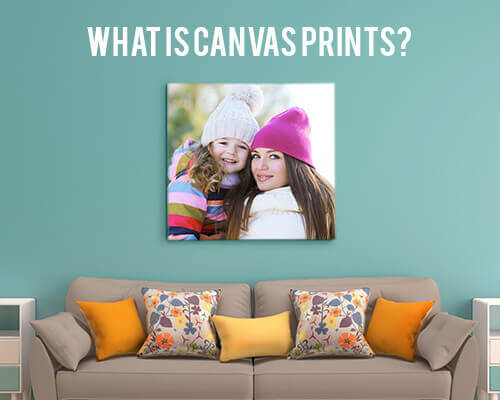Everything You Need to Know About Canvas Prints

Whether you’re a professional artist, hobbyist, interior designer, or just looking to spruce up your space with unique art, custom canvas prints are one of the best ways to express yourself! But, are you new to custom canvas prints and have many burning questions about them before you get started? Look no further than this blog for answers to anything you are curious about.
What Is a Canvas Print?
Canvas prints are images printed on canvas fabric and stretched over stretcher bars to produce ready-to-hang wall displays. Your photo or artwork becomes textured like a hand-painted painting.
Furthermore, canvas prints can be hand-stretched (gallery-wrapped) without frames or framed in elegant frames, depending on your style. They are popular in home, workplace, and business décor because they make photos look like paintings with an almost painted touch, adding depth and character.
How Are Canvas Prints Made?
In the past, canvases used to be hemp, but now they're cotton, linen, or polyester (or a mix). Printing your photo or artwork on canvas using high-quality inks begins the process. The type of canvas material can affect the final look. Polyester canvases hold ink better, producing vivid colors, whereas cotton and linen canvases more classic and textured. Modern canvas printing ensures accurate and rich image colors. In fact, advances in printing technology mean the colors on canvas prints now remain bright and true to the original image, with inks that are often UV-resistant to prevent fading over time.
Once printed, the canvas is stretched over a wooden frame. Skilled craftsmen pull the canvas taut and staple it to the back of the frame (the wooden frame ensures the canvas stays flat and tight). This is known as a gallery wrap when the image wraps around the edges of the frame for a frameless display. The result is a clean, contemporary look. If any excess canvas remains, it’s trimmed or tucked behind. The back is usually finished with hanging hardware (like a sawtooth hanger or wire) so that your canvas print arrives ready to hang on the wall.
Do Canvas Prints Look Cheap or Tacky?
People worry that canvas photos would look “cheap” or “tacky.” Someone may have asked, “Do canvas prints look cheap?” wonder “does canvas art look cheap in a living room?” Please note that canvas prints are neither cheap nor tacky. Canvas prints appear sophisticated and gallery-worthy when done well. Choosing a good canvas print service and the proper selections is crucial.
Low-quality canvas prints may have led to the belief that they are tacky. Low-resolution printing, flimsy framing, and a thin fabric that sags can make a canvas print look terrible. However, a good canvas print has rich color, tight stretching, and precise corners, looking professional. Many artists and photographers love canvases for their ageless charm.
So, are canvas prints tacky? No – not when it’s done right. Cheap-looking canvas art usually has low picture resolution or poor craftsmanship. High-resolution photographs and a trustworthy printer will make your canvas print look like art. Canvas prints are stylish and trendy, therefore many upmarket hotels, galleries, and companies employ them. Holding a high-quality canvas print will show that it's neither cheap nor gaudy, despite a few badly manufactured examples.
What’s the Difference Between Stretched vs Unstretched Canvas Prints?
When shopping for canvas prints, you may encounter stretched and unstretched canvas (or “rolled canvas”). This is an important distinction. A stretched canvas print is one that has been mounted on the wooden frame – it arrives taut, flat, and ready to hang (this is what most people imagine as a typical canvas print). An unstretched canvas print means the canvas fabric is not yet mounted on a frame; instead, it’s delivered rolled up, much like a poster, often with extra blank canvas border around the image so you can stretch it later.
Think of it this way: all canvas prints start as unstretched prints until they are wrapped around a frame. If you order a rolled canvas print, you will receive just the printed canvas material. You would then need to stretch it on stretcher bars (or have a local frame shop do it) before you can hang it. If you order a stretched canvas print, that work is done for you by the printer – they stretch the canvas over the frame and usually also attach hanging hardware.
How to Frame an Unstretched Canvas Print?
You may choose to frame or extend an unstretched canvas print to exhibit it. Two techniques to frame an unstretched canvas:
Stretch it on stretcher bars: This is the most common method. You or a professional will take the canvas and stretch it over wooden stretcher bars (like the ones used for regular canvases). The process involves assembling a wooden frame (available at art supply stores or through CanvasChamp’s canvas stretcher frames service), then carefully pulling the canvas tight around the frame and stapling it to the back. It’s a bit of an art to get it evenly taut without wrinkles.
Mount it and frame it like an art print: Alternatively, you can mount the canvas onto a firm backing and put it in a traditional frame (with or without glass). You might stick the canvas print to a foam board or thin wooden board cut to canvas size with an adhesive or special glue and frame it. This is somewhat less common, but some people do it especially for smaller canvases or if they want to use a decorative frame that has no room for stretching.
Use a floater frame (after stretching): This is more of an addition to method 1. Once you stretch the canvas, you can also place it in a floater frame (a frame that doesn’t cover the canvas edges, but “floats” around it with a gap). CanvasChamp and other services offer floater frames specifically for canvas prints. This gives a very professional gallery look. Essentially, you’d stretch the canvas, then mount that stretched canvas within the floater frame using screws – the canvas appears to float within the frame with a small border of space, which looks very elegant.
Frame vs No Frame – Which Should be Preferred?
Another frequent question is whether to add an external frame to your canvas print or display it frame-free (just the canvas). Canvas prints are often hung without any outer frame – this is called a gallery wrap style, and it’s a popular, modern look. The edges of the canvas can be printed (the image or a mirror of it wraps around), or they can be a solid color (black, white, etc.) as a border. This no-frame canvas presentation is clean and contemporary. The canvas itself, stretched on a wooden internal frame, is rigid and presentable, so an additional frame is purely optional.
Choosing frame vs, no frame for canvas really depends on the look you want:
No Frame (Unframed Canvas): An unframed canvas print, with the image wrapped around the sides or with colored edges, gives a modern gallery look. It focuses the viewer’s attention entirely on the image. This style works great for photos and artwork where the image itself is bold, and you want a minimalist display. Unframed canvases also have the benefit of being lighter and typically cheaper (frames add cost). Many people love the floating look of a frameless canvas on the wall. Because there’s no outer frame, multiple canvas prints can be arranged together without the distraction of frame styles, making them easy to group into a gallery wall. If your decor is contemporary or casual, frameless canvases fit right in.
Framed Canvas: Yes, you can frame a canvas! This usually involves placing the stretched canvas in a floater or standard canvas depth frame. This popular frame doesn't cover the front of the canvas and surrounds it with a little gap, making the painting look like it's "floating" within it. A canvas might look more formal and polished if framed, like a museum oil painting. It might also help the canvas print blend in with other framed art in your decor. A black or white floater frame can frame the image neatly, while a wood-toned frame adds warmth.
How to Hang an Unframed Canvas Without Nails?
If you can use nails or screws, the canvas's rear hanger makes hanging it easy. What if you don't want to nail the wall, especially if you're renting or have a non-damaging surface? Hanging an unframed canvas without nails is possible with a few clever solutions:
Adhesive Strips: Heavy-duty adhesive picture hanging strips like 3M Command Strips are popular. These come in Velcro-like pairs. You attach one side to the back of your canvas frame and the matching side to the wall, then press them together. They can hold a surprisingly good amount of weight if you use enough of them (check the packaging for weight limits). The best part is they come off cleanly from most walls, leaving no holes or residue. This is perfect for unframed canvas prints because the back of the wooden frame provides a flat surface where you can stick the strips. Make sure to use at least two (one on each top corner of the frame) for balance, or more for larger/heavier canvases.
Adhesive Hooks: Similar to strips, there are hooks with strong adhesive backings. You could stick two adhesive hooks upside-down on the wall and then straddle the canvas frame’s top edge onto those hooks. However, for canvases, the strips method is usually easier and less visible than hooks.
Wire or String from existing supports: If you cannot use the wall at all, another creative approach is to hang the canvas from something else. For example, some people use a picture rail (a molding near the ceiling) with wires hanging down to hook artwork. Or you could even suspend a wire or twine between two removable wall hooks (placed in inconspicuous spots) and then hang the canvas on that wire. This is less common, but it’s an idea if you absolutely cannot put any fastener where the canvas goes.
Display on Furniture: This isn’t hanging on a wall, but worth mentioning: You can also display an unframed canvas by leaning it on a shelf, mantel, or wall ledge. Small canvas prints can sit on easels or picture stands on top of furniture. If you have a bookshelf or a picture ledge, you can rest the canvas there with no wall damage at all.
Why CanvasChamp for Canvas Prints?
We pride ourselves on quality and affordability. You get museum-quality prints at very competitive prices, thanks to our state-of-the-art printing technology and experienced craftsmanship. We also have a 100% Happiness Guarantee — if you’re not satisfied, we’ll make it right. With thousands of 5-star reviews and tons of options to personalize your canvas, we’re confident you’ll love the end result.
So go ahead, turn that favorite photo into a canvas masterpiece. The process is straightforward, and in just a few days you could be unboxing your very own canvas print. There’s something truly special about seeing your memories and artwork on canvas – it’s décor with meaning, and it’s made by you (with a little help from us!). Happy canvas printing!









